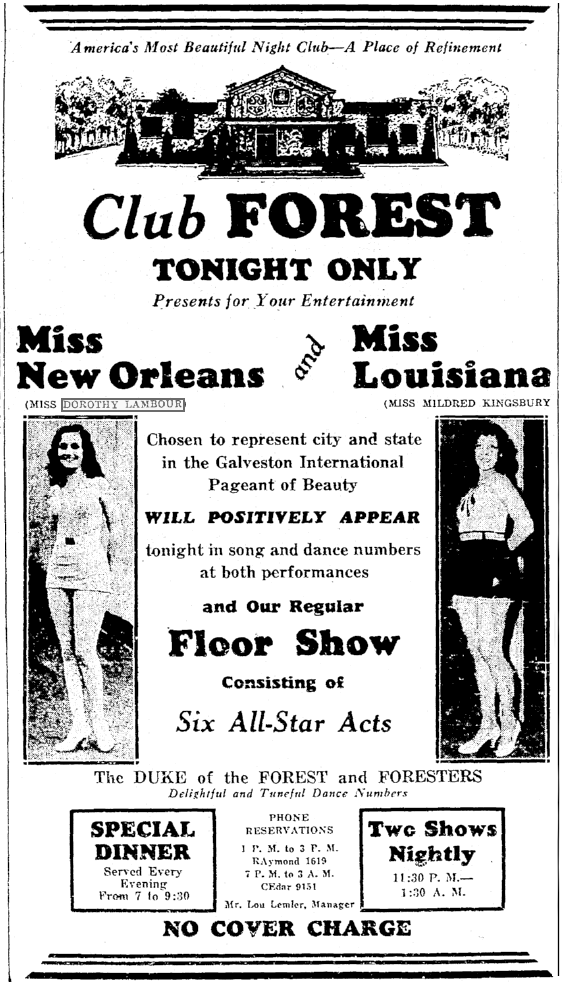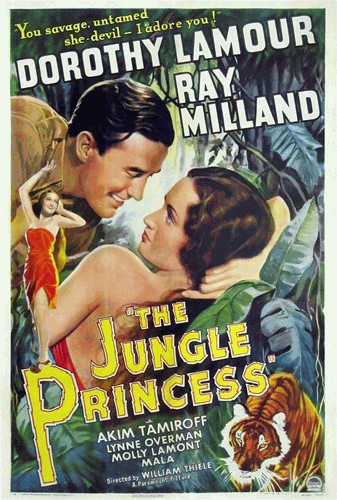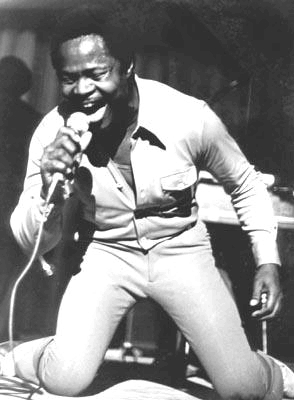|
Today in New Orleans History |
|
|
February 22



 

To receive an update for each day in New Orleans
history, join our facebook page
- Today in New Orleans History
Dorothy Lamour at the Beverly Dinner Playhouse February 22, 1974  Born in the charity ward
of Touro Infirmary ("We were not well off", she said) on December 10, 1914 (?), Mary Leta Dorothy Slaton grew up
to be a movie star. She attended Beauregard elementary school, where from she remembered playin hooky to go to Canal
Street to pay 15 cents to spend the day watching the same movie over and over again. She was hooked. The daughter of John Watson Slaton and Carmen Louis LaPorte, she was also raised by her cousin Jeanne Deshotels
and her mother Jeanne Schwerz. After divorcing Slaton, Carmen married Clarence Lambour and Dorothy took his last name.
Deshotel remembered taking the young "Dottie" to St. Louis Cathedral whereupon the child sang the 1918 jazz hit
"Ja-Da (Ja Da, Ja Da, Jing, Jing, Jing!) when the organ began playing. "I was so embarrassed", she said, "I
couldn't shut her up". As a teenager, she began entering
beauty contests. In 1929 Dottie took first-place in a Biloxi pageant and earned the title Miss American Legion of New Orleans.
On July 26, 1930 she was a contestant, along with her friend Dorothy Dell Goff, in the Miss New Orleans beauty contest at
Pontchartrain Beach's original location at Bayou St. John and the lakefront. Goff was crowned queen, and Dottie took
fourth place, in front of a crowd reportedly of 10,000 people. A
few weeks later, on Friday, August 1, 1930, Dottie and Dorothy boarded a 9 p.m. train at Union Station along with their mothers
to head to Galveston for the International Pageant of Pulchritude (the Miss America and Miss Universe contests). Dottie's
ranking in the New Orleans pageant qualified her as an alternate for Goff, who was crowned Miss United States (Miss America)
on August 5, 1930 and then Miss Universe on August 10, 1930 in the Texas pageants. Goff, as Dorothy Dell became a film
actress whose young life was cut short in an automobile accident on June 8, 1934 near Pasadena, California. Dottie Lambour won the 1931 Miss New Orleans contest wearing a blue bathing suit and a blue linen dress she
had bought on Canal Street for $2.98. Miss Lambour is seen here
in an advertisement for Club Forest (407 Jefferson Highway) on June 7, 1931. She did, in fact, go on to the 1931 Galveston
pageant but failed to take a crown. She attended Spencer Business College and took a job in the real real estate business
but still dreamed of fame. According a 1974 interview with local writer David Cuthbert, Dottie bought two tickets to
Chicago, left one along with a note to her mother, and left New Orleans for a bigger city. Her mother arrived the following
day. They took jobs in a restaurant, with Carmen in the kitchen and Dottie waiting tables. She said the trays
were too heavy for her to carry so "I walked into Marshall Field Department Store. I had a terrible inferiority
complex but when you do you put up more of a front." "I want to see the supervisor" she said, to which
the response was "Which one?" "Well that stopped me. At D.H. Holmes and Maison Blanche all they had was
one. In those days at Marshall Field they had nine. All I could get out was 'I want to ride an elevator'. She got the
job.While performing at a night clubs she was "discovered" by orchestra leader Herbie Kay who hired her to sing
for his band. On November 14, 1932 she was back in New Orleans
and back at Club Forest performing with Kay's "nation-wide famous band" featuring Dorothy Lambour (Miss New Orleans
1931)". She later said that a Dallas sign painter left the "B" out in her name on a hotel display announcing
the band's performances and that Herbie Kay adivised her to let it be, and so she became "Dorothy Lamour".
She also became Mrs. Herbie Kay/Mrs. Herbert F. Kaumeyer on Monday, May 13, 1935. "Without Herbie, I don't think I'd
be in show business", she said.  A November 23, 1936 article mentioned that Dorothy Lamour "once of New Orleans, is seen in a short feature on the Saenger
bill" which was likely a short film adopted from her New York radio show "Dreamer of Songs". Local entertainment
writer Charles P. Jones, in a January 17, 1937 article, briefly reviewed "Jungle Princess" (starring Lamour and
Ray Milland) which was playing at the Tudor Theater. "Miss Lamour is given a chance to sing as well as act, and
the picture is certain to make its heroine and impressive movie figure", he wrote. And so it was. Not to
mention that Dottie's "impressive figure" was wrapped in a sarong which made her as famous as she made it. A November 23, 1936 article mentioned that Dorothy Lamour "once of New Orleans, is seen in a short feature on the Saenger
bill" which was likely a short film adopted from her New York radio show "Dreamer of Songs". Local entertainment
writer Charles P. Jones, in a January 17, 1937 article, briefly reviewed "Jungle Princess" (starring Lamour and
Ray Milland) which was playing at the Tudor Theater. "Miss Lamour is given a chance to sing as well as act, and
the picture is certain to make its heroine and impressive movie figure", he wrote. And so it was. Not to
mention that Dottie's "impressive figure" was wrapped in a sarong which made her as famous as she made it.Costume designer Edith Head admitted that her sarong was "born"
for "Jungle Princess". "It wasn't even authentic", she said. A real sarong wrapped the body
only below the waist but that "wouldn't clear any censor". Head also described the process of selecting the
sarong wearer for "Jungle Princess"; a nation-wide search by the studio brought in state winners for screen tests;
each young woman wore the same sarong, same bracelet, and same blossom behind their ears; the wolf-whistle originated during
Lamour's screen test as stage-hands watched and the wolf-whistle became a "system" at the studio whereby a certain
number of whistles predicted a young actress' probable popularity with the general public. The sarong and Lamour teamed with Hope and Crosby and went "on the road" to Singapore (1940), Zanzibar
(1941), Morocco (1942), Utopia (1946), Rio (1947), to Bali (1952), and Hong Kong (1962). Dottie came home to celebrate
her 50th birthday on December 10, 1967 while on a tour starring in "Hello, Dolly!" which ran at the Municipal Auditorium
on Saturday, December 16. Back home again to perform in "Fallen Angels" at the Beverly Dinner Playhouse on
February 22, 1974 she said to David Cuthbert of the Times-Picayune "Honey, those studios biographers
didn't care what they said about you. They had me born in Chicago, New York, got may age wrong -- I don't care what
the World Almanac or the film books say, I am 56, NOT 59!" Dottie
made a total of 50 flims, seven of them in the "Road to..." series. During World War II she performed for
GIs, hosted at USO facilities, was one of the most popular pin-up girls, and was not only the first star to volunteer to sell
war bonds but is also credited with selling some $300 million worth of them. In later years she toured with theatrical
shows and became more active in volunteer service. Referring to the 1987 film ''Creepshow 2,'' where she played sloppily
housewife who is murdered, she said ''Well, at my age you can't lean against a palm tree and sing 'Moon of Monakoora.'' Dottie
died on September 22, 1996 in North Hollywood at the age of 81.
|
|
|

To receive an update for each day in New Orleans history,
join our facebook page - Today in New
Orleans History.
Analytics |


